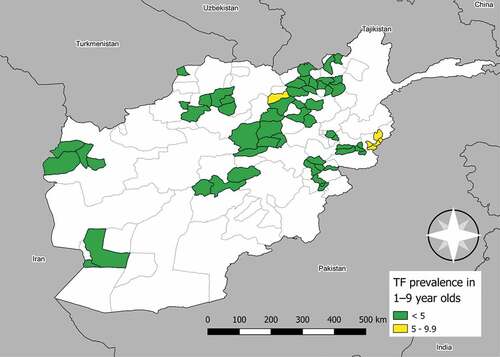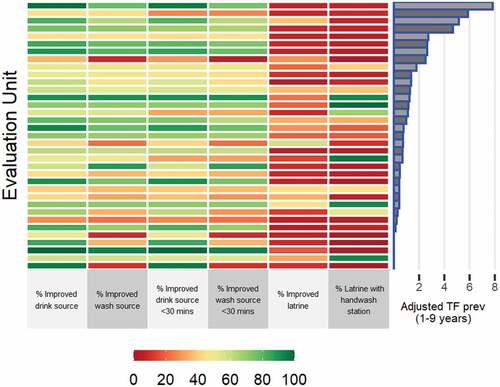Figures & data
Table 1. Population aged ≥1 year enrolled in trachoma prevalence surveys in Afghanistan, September 2018–December 2019.
Figure 1. Prevalence of trachomatous inflammation—follicular (TF) in children aged 1–9 years in Afghanistan. Surveys conducted from September 2018–December 2019. The boundaries and names shown and the designations used on this map do not imply the expression of any opinion whatsoever on the part of the authors, or the institutions with which they are affiliated, concerning the legal status of any country, territory, city or area or of its authorities, or concerning the delimitation of its frontiers or boundaries.

Table 2. Age-adjusted trachomatous inflammation—follicular (TF) and trachomatous inflammation—intense (TI) prevalence in children aged 1–9 years in Afghanistan, September 2018–December 2019.
Table 3. Age- and gender-adjusted prevalence of trachomatous trichiasis (TT) unknown to the health system among people aged ≥15 years in Afghanistan, September 2018–December 2019.
Figure 2. Percentage of households with improved water, sanitation and hygiene facilities in evaluation units surveyed for trachoma in Afghanistan in September 2018–December 2019. Data are presented in descending order of evaluation unit-level age-adjusted trachomatous inflammation—follicular (TF) prevalence (%) in children aged 1–9 years from top to bottom.

Table 4. Univariable and multivariable multi-level hierarchical binomial mixed-effects regression analyses of variables associated with trachomatous inflammation—follicular (TF) in children aged 1–9 years in Afghanistan, September 2018–December 2019. All models include evaluation unit, cluster and household as random effects parameters.
